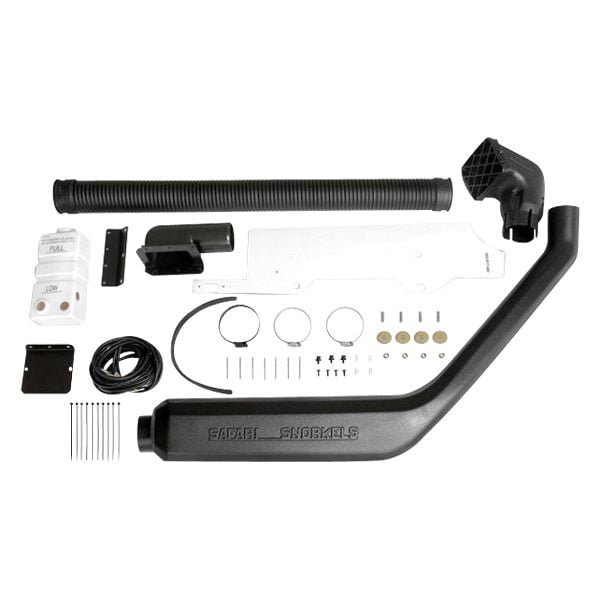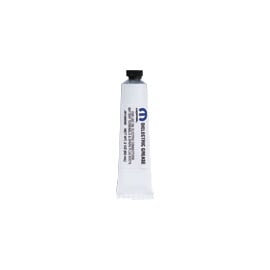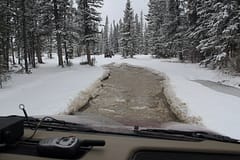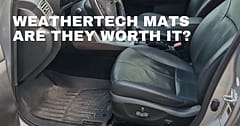Tips for Driving Through Water
4x4 Water Crossing Techniques and Training
Contents
- Introduction
- Vehicle Preparation for Driving in Water
- Axles & Breathers in Water
- Air Intake in Water
- Engine Bay Protection from Water
- Radiator Fan
- Driving Technique for Water
- What happens if my engine stales in water?
- Vehicle Maintenance After Driving Through Water
- How to Drive Through Water Summary
Introduction
There is one thing I can tell you about water – it’s WET!
Water crossings can provide some of the most exhilarating and challenging 4x4 Driving around. They can also prove to be the most expensive! So, if you’re not an Auto Mechanic or Auto Electrician then be prepared for those less agreeable quotes from your local 4x4 garage that usually start with “Open your Wallet Sir and say after me HELP YOURSELF!” This information is also important if you are driving through a flood or maintaining your vehicle after driving through a flood.
As a Boat Builder/Designer/Marina Developer and Owner for 30 years as one of my businesses, I can confirm that “WET” and Mechanical/Electrical working parts don’t go well together.
This content was developed by and owned by Paul Sinkinson, Xplorability owner. Paul is a 4wd Defensive Driver Training Consultant/Trainer and Programme Developer.
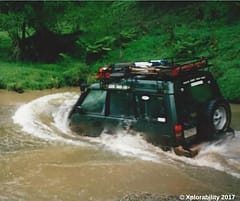
This really is as extreme as you ever want to go unless you are an Olympic Swimmer. This was on a 4wd Trek drive by a very experienced off-roader in a well prepared Discovery BUT it could still have been touch and go at this depth.
Generally speaking, your 4x4 is not an amphibious vehicle; in fact it’s not even waterproof. The actual depth that you can cross depends on your vehicle. For example, some of the smaller versions may well be submerged at the depth that a Defender or Discovery doesn’t even wet its door sills.
As a general guide, if the water you are driving in is above the top of your wheels you are probably in too deep. A water crossing should not be attempted by the inexperienced or in a poorly prepared 4x4 Vehicle.
Prior to crossing water, it is a good idea to place your recovery gear on top of other kit. The last thing you want to do is be searching under everything else when you are stuck in the middle of a river crossing. In fact, it’s also a good idea to connect up your tow straps front and rear to be ready for an extraction and if you have one, test that your winch is operational and ready to go just in case.
Driving through water isn’t something that should be taken too lightly. Do it wrong and you could do expensive damage to the drive-train and the engine. However, with the right vehicle preparation and post crossing maintenance, you can enjoy some of the most challenging 4x4 driving.
Taking a break at a shallow and peaceful water crossing
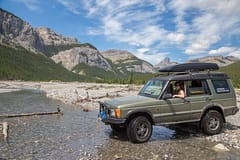
WARNING:
It is very easy in the company of friends and their 4x4 vehicles to be “Gung Ho!” and drive blindly into water making massive splashes and waves. THIS is when the accidents and incidents happen that endanger you and others, damage the environment and wreck your pride and joy. Drive sensibly, responsibly and with mechanical sympathy.
Take Water Crossings seriously – They are NOT for “Playing” about in
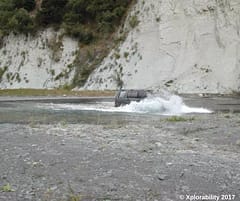
Vehicle Preparation for Driving in Water
If you are not familiar with a particular crossing, the first thing to do before driving it may be a good idea to walk it. (Unless I am on my own, I usually delegate at this point to a willing (experienced) passenger).
If you cannot walk it, you cannot or perhaps should not attempt cross it. If the water is flowing too quickly to safely walk the crossing, then it cannot be driven across. Remember, even heavy vehicles will actually float until water seeps into them. Walking the crossing is the first action in your vehicle preparation. While you are doing the “Big Toe Test,” during the time spent, you’re axles, diffs and gearbox are cooling down while you find out exactly how deep the water is.
Remember, moderate flow of water may, if your vehicle tries to float at any point, it may drift down stream and you may miss your exit point and be unable to drive out. If there is a flow, take that into account and aim slightly upstream of your intended exit so that if you do drift you can still make it out where you intended. Bear in mind when you read this that some of us have seen 6 wheel drive heavy vehicles float sideways in flowing water and Defenders float, get caught up and roll over.
Walk the Crossing – It is best if it’s the Driver or an Experienced Passenger.
When doing this, as well as for checking the depth, its best to walk in the path of your intended wheel tracks to find if there are any hidden potholes or boulders. Potholes are often caused by the spinning wheels of other vehicles that have chewed up the gravel when suddenly halted after hitting a submerged rock. So if you find a pothole, check for submerged rocks. If you have been well prepared enough to have any canes, it’s a good idea to place them as markers at these points so you can avoid them. It has been known for a vehicle attempting a relatively easy crossing to come unstuck when a single pothole has caused the vehicle to momentarily submerge allowing water into the air intake with resultant engine damage.
Axles & Breathers in Water
A hot axle cools rapidly when it enters the water and this has the effect of lowering the air pressure inside the casing and the differential housing, causing air to be drawn in via the differential breathers. If the breather tube is below the water line then it will also suck in water, which will emulsify the oil. Extending your differential breathers higher up the chassis with the aid of plastic tubing is a “must do” if you intend to do regular water crossings. However, it is no guarantee that water will not enter your differential and any sudden reduction in air pressure inside can still cause water to be drawn in via the axle seals if the diff breathers do not equalize the pressure quickly enough. Even when extended diff breathers are fitted this is the reason why it’s still necessary to allow the vehicle time to cool down.
Air Intake in Water
Water and engines never mix very well, and when they do it almost always results in bent connecting rods, valves stems and crankshaft. If you think this sounds expensive you’re correct. The positioning of the air intake is critical to how well a vehicle can handle a crossing. Many 4wd vehicles have their standard air intake directly behind the headlight. This is great for allowing cold air into the engine but unfortunately is equally as great at directing water into the engine.
NEVER, EVER, attempt a water crossing where the water depth is above the standard air intake height if the vehicle has not had the necessary preparation.
If you intend doing regular water crossings, it’s definitely a good idea to fit a snorkel as it raises the air intake to your roofline. (Don’t forget those extended axle breathers and any other Breather kits that may be applicable). But remember, this doesn’t mean you can use your vehicle as a submarine! You may be laughing at that BUT, believe me some drivers do think like that.
Engine Bay Protection from Water
Carrying a suitable plastic sheet or even placing a large plastic sack across the front of the vehicle will reduce the amount water entering the engine bay and improve the bow wave effect. This is providing that you maintain forward momentum. It will also result in less water being caught up with the radiator fan and spraying over the ignition and charging system as well as the ECU’s Fuse Compartments etc. There should be less chance of water entering the air intake and also less likelihood of the fan distorting and damaging the radiator fins.
Diesel vehicles usually fare better on water crossings, as they do not have the ignition system to worry about. Water in the ignition system usually results in a stalled engine or misfires and not actual engine damage, but this is of little comfort when you find yourself stuck in the middle of a river crossing.
To try and minimize an engine stalling from a wet ignition, it’s a good idea to spray all the ignition system with water repellent beforehand. If fitted with a Distributor Cap in the system you can also use a smear of waterproof silicone grease around the cap rim joint to prevent water ingress.
Dielectric Grease
TIP: It may sound silly, but cutting the base off a suitably sized plastic drinks bottle so that the remaining top part slides over the distributor cap, running and sealing the leads through the neck can reduce condensation on the inside of the distributor cap as it tends then to form up inside the plastic bottle instead.
Radiator Fan
While you are under the bonnet spraying water repellent, check to see what type of radiator fan is fitted. Most modern 4x4 vehicles have the viscous coupling type. With these, if the engine is cool enough the fan doesn’t spin. With the engine off and ignition key OUT, try and turn the fan. If it turns easily, you will probably get away without having to take the fan drive belt off. If it doesn’t turn easily or yours is the fixed type, then you should remove the fan belt. The reason for this is that if you don’t and water enters the engine bay, the fan may act like a boat propeller, bend forward and damage your radiator. That’s definitely something you don’t want to discover once you’ve completed the crossing. Even if the radiator survived, you don’t want water being sprayed around, especially in a petrol vehicle.
Familiarity breeds contempt! Just because it was easy the last time you crossed at a place doesn’t mean it will be the same months onwards. ALWAYS check! Here the Winter Floods had eroded the river base, which came as a shock to this driver_
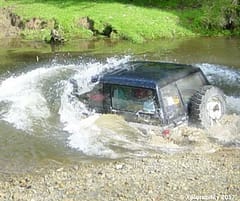
Driving Technique for Water
Ok, are you ready? By now you should have a mental picture of your route, after all you’ve possibly had to roll your trouser legs up and walk it. Better still, you may have set your markers in place, and with all your vehicle preparation done, its time to take the plunge (NO THAT’s NOT THE WAY!) It is time to start the crossing. Before you enter the water, remember to take off your seat belt and if you are going to drive it sensibly, wind down your window. If you do get stuck, you may have to get out and the window could be the best option as if you do open the doors it’s going to be “Messy!”
You’ve chosen your route, enter the water slowly using low range second gear normally running at circa 1500-2000 rpm (for most vehicles). You choose second gear to reduce the likelihood of wheel-spin if you hit an obstruction. Progress forwards and the bumper/bull bar front of the vehicle will start to push the water in front of it just like a ship does. This is called the bow wave. As you continue forwards pushing the bow wave, just back off the throttle momentarily and “Bingo” you will now see the crest of it just appearing in front of the bonnet/hood in your eye line. Its important now to get the speed just right and so follow the wave at the same speed. Too fast and you will pass over it and send water everywhere, too slow and you will lose the effect of it and you may flood the engine bay.
OK, this is just a gentle example of a “Bow Wave” being pushed ahead of the vehicle. Here, the driver has just slowed down prior to exiting the crossing to let the “Wave” ride the bank ahead of him
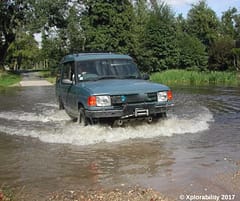
If you have a look sometime at a Ship or Boat on the river or a video of one you will see it pushing a Bow Wave. The wave crest is in front but behind it is the “trough”. That’s what you are aiming for as, that “trough” is your best friend for the next few minutes as it drops lower, normally well below the engine bay and door sills and it keeps water away from your working parts and electrics.
You will have already planned where you are going to exit so keep the bow wave in your peripheral vision while you concentrate on the exit ramp.
DON’T Be tempted to speed up to much for the run out or you will just be splashing water everywhere. Ease off the power just before the exit so you make sure you have good traction as the bow wave will exit before you. Once that has hit and ridden the bank in front you can then use just enough power to drive you out without inducing wheel-spin.
Hopefully you will have followed your markers making it to the other side without problems. If you do strike problems (in a Manual) avoid using the clutch as this could allow water to get between the flywheel and the friction plate, which could limit the drive.
You may find the wheels start to slip if you do get in a hollow or touch a boulder so it’s important not to over-rev the engine. If it happens, back off the power slightly and the wheels should regain traction. Too much throttle only creates excessive wheel-spin which, will not help and of course it throws water everywhere.
Here, the vehicle has hit a submerged boulder and now has added too much power – the “Washing Machine” effect
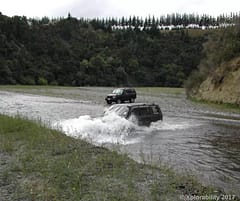
What happens if my engine stales in water?
If the engine stalls, engage neutral without using the clutch (if you can) and attempt to restart. If you’re lucky, the engine will restart. Because you will be stationary, there will be standing water in the engine bay so if you haven’t the viscous fan system and haven’t removed the fan belt everything in there is going to get a dowsing. (NOT GOOD). Once you restart, it’s normally best to use 1st gear low range, engaging it with a minimum of clutch usage, try and extricate yourself from this predicament. If you’ve a petrol motor it could well be spluttering and misfiring, hence the choice of first gear as in second gear it could stall again.
Well, you hopefully made it OK and you may have a few more to do on your current trip or at least maybe have to come back across the one you have just driven. Whatever, you now need to check everything over, especially if that last one was a deep one. Check the engine bay; dry off any excess from the electrics that you can get at. Remove any sheets from the front grill that you used to block the water from the fan and air intake and then make sure you check your brakes are working. Take it easy as you do that.
Because of the river flow, it was necessary to drive slightly upstream of the intended exit just in case the vehicle floated at any time during the crossing which could have lad to missing the exit.
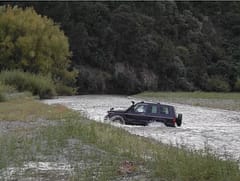
Vehicle Maintenance After Driving Through Water
This next part is really for if you are doing lots of water crossings on a long trek but the basics still apply.
Just because you have extended differential breathers isn’t a 100% guarantee that water will not get into the axles. Any crossing above your axles without extended breathers means that they need a definite inspection. Checking them for water contamination is very easy. Water is heavier than the oil so it will collect at the lowest point in the differential where the drain plug is located.
After allowing time for things to cool, loosen the drain plug and run a small amount of the diff oil into a suitable container. If you’re unlucky enough to have water present, the oil should be drained. It is best to flush the diff several times to ensure all traces of water are removed. Milky coloured oil also indicates presence of water and should also be changed.
Of course, unless you were prepared for it and carry sufficient replacement oil etc., you won’t be able to change the differential oil until you get home. So, if you suspect contamination ( for instance after a deep water crossing without extended breathers or if you are aware you have leaking seals) then you can try and remove the water by draining from the differential until only oil comes out the drain hole. Don’t drain too much off and leave your diff short of lubrication. Don’t dump the waste oil and water emulsion as it’s not environmentally friendly. Save it till you get back home and dispose of it properly.
Of course, if the vehicle has spent a lot of time in standing water, it may not be just the axles that have issues with water ingress. Gearboxes, transfer case and engine oil could also be affected. Make sure you keep an eye on this with regular checks.
Front bar mounted electric winches and other items may also be affected so check them through. Winches are not used very often and you don’t want to find they have seized up just when you need them the most. If a winch has been submerged in water for any length of time it is advisable to strip it and grease it accordingly. It’s always worth a quick test of it after a crossing to prove it still works, but still give it a good check and grease when you get home.
How to Drive Through Water Summary
Driving in Water Vehicle Preparation
- Walk the crossing to check its depth if required.
- Don’t cross fast flowing water.
- Place markers at hidden obstacles if possible.
- Place a plastic sack or similar sheet across the front of the vehicle.
- Disconnect the fan belt if a viscous coupling fan is not fitted.
- Spray water repellent on distributor and ignition wires.
- Pack recovery gear on top, ready for use. Preferably connect Tow Strap front and rear.
Water Driving Guide
- It may be advisable to Take off your seat belt just in case to have to escape. It may be possible to drive with he window open for the same reason.
- Use low range 2nd gear (in most situations).
- Drive at a steady speed to create a bow wave.
- Avoid using the clutch on a manual.
- Do not over-rev engine if you lose traction.
- If engine stalls, place in neutral without using clutch to restart. Set off again slowly in 1st gear low range.
After Crossing Water
- Check differentials etc. for water if depth above axles.
- Check winches and other equipment if fitted.
- Dry off Electrics etc. in Engine Bay – Replace Drive belts if previously removed.
- Check your Brakes.
- On return home double check all Differential, Gearbox and Engine oils.
- Give everything with a grease nipple a good check and grease up.
Enjoy the Journey
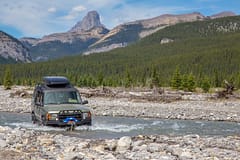
Previous Article: Rough and Rocky Tracks
Next Article: 4x4 Vehicle Recovery
Check out other work by Paul, fiction thriller novels here.
Copyright
This content was prepared for the Off-Road Discovery Website by Xplorability 4wd Training
The Content - All Photographs and Photographic Copyright and All other Rights other Reserved October 2017. S.W. France. This content may not be copied or reproduced without the written consent of Paul Sinkinson – Xplorability Training.
For Use Only in 4wd and Light Vehicle Driver Training.
Not for Re-Publication, Distribution or use outside the Xplorability Training Programme
